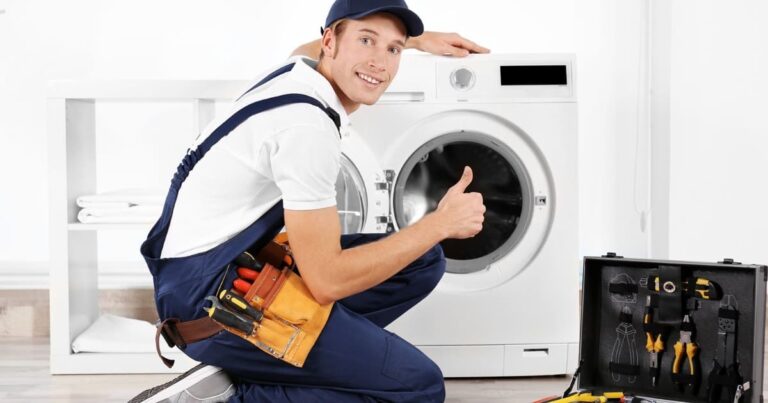Washers and dryers are indispensable appliances in modern households, streamlining the laundry process and saving valuable time and effort. However, like any mechanical device, washers and dryers can experience issues and malfunctions over time. In this comprehensive guide to washer and dryer repair we will explore common problems, troubleshooting techniques, appliance repair, maintenance tips, and solutions to help you keep your laundry appliances in optimal working condition.
Understanding Washer and Dryer Components:
Before delving into repair and maintenance, it’s essential to understand the basic components of washers and dryers:
1. Washer Components:
- Drum: The drum is the large, rotating cylinder inside the washer where clothes are placed for washing.
- Agitator or Impeller: Found in top-loading washers, the agitator or impeller moves clothes around to facilitate cleaning.
- Water Inlet Valve: The water inlet valve controls the flow of water into the washer during the wash cycle.
- Pump: The pump drains water from the washer at the end of the wash cycle.
- Motor: The motor powers the washer’s operation, driving the drum and other moving parts.
2. Dryer Components:
- Drum: Similar to the washer, the dryer drum is the rotating cylinder where clothes are placed for drying.
- Heating Element or Gas Burner: The heating element or gas burner generates heat to dry the clothes.
- Blower Fan: The blower fan circulates hot air through the drum, expelling moisture from the clothes.
- Thermostat: The thermostat regulates the temperature inside the dryer to prevent overheating.
- Timer or Control Panel: The timer or control panel allows users to select drying cycles and settings.
Common Washer and Dryer Problems:
- Washer Not Draining:
- Solution: Check for clogs in the drain hose or pump filter. Inspect the pump for damage or obstruction and replace if necessary. Ensure the drain hose is properly installed and not kinked.
- Dryer Not Heating:
- Solution: Verify the power supply and check the heating element or gas burner for continuity using a multimeter. Replace the heating element or gas igniter if defective. Clean the dryer vent to ensure proper airflow.
- Washer Leaking Water:
- Solution: Check for leaks around the water inlet valve, hoses, and door seal. Tighten loose connections or replace damaged components. Inspect the detergent dispenser and drain pump for leaks.
- Dryer Making Loud Noise:
- Solution: Examine the drum bearings, rollers, and idler pulley for signs of wear or damage. Lubricate or replace worn components to reduce noise. Clean the blower fan and housing to remove debris.
- Washer Not Agitating:
- Solution: Inspect the agitator or impeller for damage or obstruction. Test the motor coupling or drive belt for wear and replace if necessary. Check the motor and transmission for faults.
Maintenance Tips for Washers and Dryers:
Regular maintenance can help prevent issues and prolong the lifespan of washers and dryers. Here are some maintenance tips to follow:
- Clean the Lint Trap: After every dryer cycle, clean the lint trap to improve airflow and prevent fire hazards.
- Inspect Hoses and Connections: Regularly check the washer hoses and connections for leaks, cracks, or corrosion. Replace any damaged components promptly.
- Clean the Washer Drum: Periodically clean the washer drum and detergent dispenser to remove soap scum, residue, and mildew buildup.
- Ventilate the Dryer: Ensure the dryer vent is clear of lint and debris to prevent overheating and improve drying efficiency.
- Level the Appliances: Check that the washer and dryer are level and properly balanced to prevent vibration and noise during operation.
When to Seek Professional Help:
While many washer and dryer repair can be DIY-friendly, some issues may require professional assistance. Consider seeking help from a qualified appliance repair technician if:
- The repair involves complex electrical components or gas lines.
- You are unsure about how to diagnose or fix the problem.
- DIY attempts have not resolved the issue or have made it worse.
Frequently Asked Questions (FAQs)
What is appliance repair?
Appliance repair refers to the process of diagnosing, troubleshooting, and fixing issues or malfunctions in household appliances such as refrigerators, washing machines, dryers, ovens, dishwashers, and more.
When should I consider repairing my appliance instead of replacing it?
Repairing your appliance may be a cost-effective option if the repair cost is significantly lower than the cost of purchasing a new appliance. Additionally, if the appliance is relatively new, has sentimental value, or meets your needs, repairing it may be preferable.
What are some common signs that my appliance needs repair?
Common signs that your appliance may need repair include unusual noises, failure to start or operate, inconsistent performance, visible leaks, strange odors, or error codes displayed on the appliance control panel.
Conclusion:
Maintaining and repairing washers and dryers doesn’t have to be daunting with the right knowledge and resources. By understanding the components, identifying common problems, and following maintenance tips and solutions outlined in this guide, you can troubleshoot and address issues with your laundry appliances effectively. Remember to prioritize safety, use proper tools and techniques, and seek professional help when needed to ensure the continued functionality and longevity of your washers and dryers for years to come.


Comments are closed.